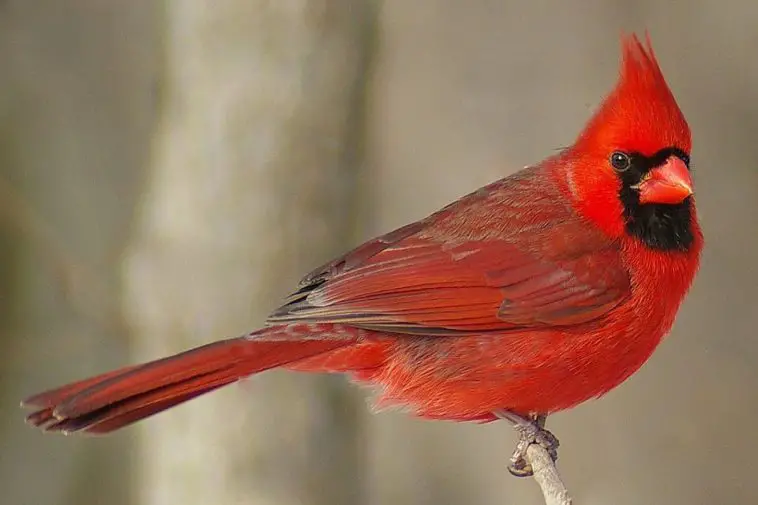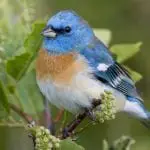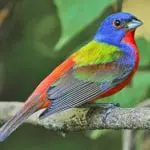Scientific Facts
| Common Name | Northern Cardinal, Redbird, Virginia Nightingale |
| Scientific Name | Cardinalis Cardinalis |
| Wingspan | 25 to 31 cm |
| Life Span | 13 to 15 years |
| Clutch Size | 2 to 5 eggs |
| Habitat | Wetlands, Woodlands, Shurblands, Gardens and Parks |
| Country of Origin | United States, Central America |
Physical Description
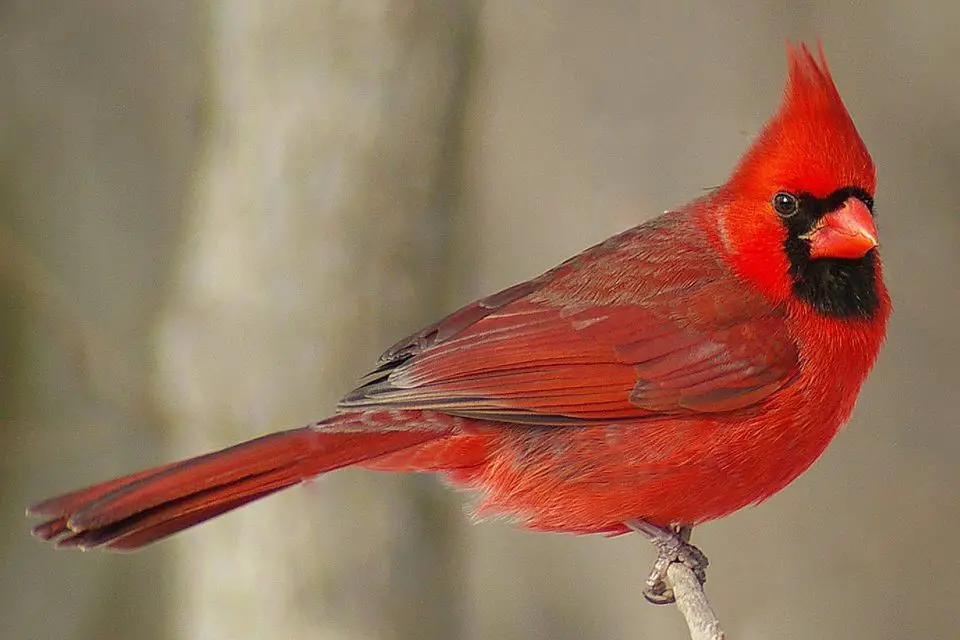
Northern Cardinals are among the most popular bird species in all of North America. They are also known as common cardinal, redbird, as well as Virginia nightingale. These birds are easily recognizable and are very familiar. For this reason, they are simply called cardinals instead of their full names.
They are named as such because of the male cardinals’ brilliant red plumage, reminding anybody of the European settlers of the vestments of cardinals of the Catholic Church hierarchy. The crest of the birds also reminds of the headgear of higher religious officials.
The red color of the plumage of these birds come as a result of the presence of carotenoids in their features. They ingest these substances through their diet. On really rare occasions, a vibrant yellow Northern Cardinal may be observed.
Northern Cardinals are dimorphic birds. Even though the red males are easily recognizable, the females, which are usually camouflaged, also look elegant and lovely. Female birds have a warm and soft color, with a bright orange bill and red edges to their wings and tail. Females are also observed to have red wash across their chest, though this may still be different between individuals.
These birds usually go bald, with the tendency of losing all their feathers on the head, showing dark gray or black skin instead. This can be worrisome to look at, though it is but a part of their molting cycle. In certain cases, parasite or mite infestations may contribute to this temporary issue, though the features are expected to regrow eventually.
The orange, yellow, or red pigments that are naturally present in plants are mainly responsible for the red coloration that is exhibited in the feathers of the male birds. These pigments, called carotenoids, are not produced within the body of the bird but are usually ingested by consuming plant material that contains the insects or pigments which have fed on colorful plants.
Background
Northern cardinals belong to a family that is composed of 19 subspecies that are distributed across the USA, Canada, and Mexico. During the 19th century, they were kept as cage birds. This practice was controlled and prohibited from 1918. Cardinals are often seen in many gardens since they feed on pest insects while singing beautiful songs. The population of these birds is stable and large. As such, they are not currently on the list of endangered species.
Habitat
The habitat and range of Northern Cardinals are evident in the presence of the term “Northern” in its name. It refers to the worldwide locale of the habitat of these birds. Among all of the three recognized species under the Cardinalis genus (Northern, Vermillion, and Pyrrhuloxia), Northern Cardinals are the ones present in northernmost regions.
There are over a dozen subspecies of northern cardinals. Out of those, only four are recorded in the north of Mexico. All of the subspecies are easily recognizable as cardinals, though there are still some subtle variations in terms of overall size, color intensity, and crest size.
These birds are usually found throughout most parts of the Central, Eastern, Southern, and Southwestern United States, as well as in Belize, Guatemala, and Mexico. This species is found in the northernmost of the cardinal species, with most of them being cardinal birds. This species does not migrate.
Because of the adaptability of these birds, as well as currently existing bird-friendly urban and suburban landscapes, the range of Northern Cardinals has expanded in many areas, including the West and the North. There has been some habitat loss reported which are linked to population declines in the southwestern part of their range. Over the last 200 years, northern cardinals have been observed to expand their range, moving toward areas that are warmer, and closer to humans, considering them as a reliable source of food.
Population
According to the records of the Animal Diversity Web resource, the population size of northern cardinals is about 100 million. Also, the All About Birds resource explains that the total breeding population size of northern cardinals is at 120 million birds, with 77% of them resident in the United States, while about 22% are present in Mexico. All in all, northern cardinals have been classified as Least Concern (LC) under the IUCN Red List. Up to this point, their numbers remain stable.
Lifespan
Even though most Northern Cardinals live around three years in the wild, the longest recorded lifespan for a cardinal was recorded at more than 15 years. Since these birds stay within their same territory all year round, a birder may easily observe the same cardinals visiting their feeders for several years.
Popularity
These birds are popular mascots in sports teams. They are not just the mascots for the Arizona Cardinals NFL team and the St. Louis Cardinals baseball team, but also for various schools. This includes the Ball State University in Indiana, Lamar University in Texas, the University of Louisville in Kentucky, Wesleyan University in Connecticut, as well as the State University of New York in Plattsburgh. There are also a number of high schools elementary schools and junior high schools that use cardinals as mascots.
Due to their beautiful appearance, musical songs, and dedication to mates, northern cardinals have become among the most popular species for both birders and non-birders. For this reason, cardinal motifs can be observed on several bird-themed gifts, including crafts, figurines, collectibles, and others. They are also popularly seen on Christmas cards and other winter decors.
Pigmentation and Coloration
Just like several other bird species, flamingos included, cardinals achieve their bright colors from their diet. Many of the seeds and berries consumed by these birds contain carotenoid pigments. These pigments, in turn, convert to the red coloration that is seen in adult male birds.
However, it should be noted that not all male cardinals achieve the bright red coloration that they are quite famous for. In fact, a small percent of the population features a unique genetic variation that is known as xanthochroism. Birds that have this genetic defect lack an enzyme which converts yellow pigments into red color, making the birds look like bright yellow, rather than red.
Song
Both male and female Northern Cardinals are good singers. These birds even love it so much that they may do so all year round. Female birds are observed to sing while sitting on their nest, which are also found as a good way to communicate the need for more food to their partners. Females are also observed to have a more elaborate singing compared to males. Another interesting information about the song of Northern Cardinals is that one cardinal may have over two dozen variations of songs, with different geographic populations often having different songs.
Behavior
Northern Cardinals are aggressive birds. Males, especially, may defend their territories violently. They end up chasing their competitors away. It is also amusing to see them attacking their own reflections in windows, mirrors, chrome bumpers, as well as other reflective surfaces, usually spending hours attacking anything that they assume as unwelcome intruders.
These birds usually live in forests as well as in thick bushes that surround residential areas. These are places where these birds find it easy to gather food. They feature strong beaks that help them in digging for insects in bushes and biting into fruits, grains, and seeds. The females are observed to build nests using bits of shrubs, twigs, and grass. They usually do so in the middle of thick bushes, providing them protection against predators such as dogs, cats, owls, snakes, chipmunks, squirrels, and others.
As soon as predators get too close to their nests, the parent cardinals give off a shrill chirp in order to drive them away. Every year, females lay three eggs on the average but are capable of hatching up to five. Around a period of two weeks, females incubate their eggs. Meanwhile, the male brings her food while keeping predators at bay. These birds are songbirds, as they use calls and songs to communicate with each other. Male cardinals often use a combination of fluffing of feathers and singing in order to attract the attention of females. Mating couples usually sing a similar whistle together.
These birds are not migratory. Instead, they are a resident year-round within their range. In the daytime, they are active, particularly in the morning and evening. In winter, they usually feed in large groups, reaching about 60 to 70, usually in open ground thickets, though they are also observed to forage in trees and bushes. Males can be really territorial, even defending their territory against other males. Even when they see their own reflection, they may try to fight what they think is an intruder. These birds mainly use vocalizations and physical displays to communicate.
Parenthood and Family Life
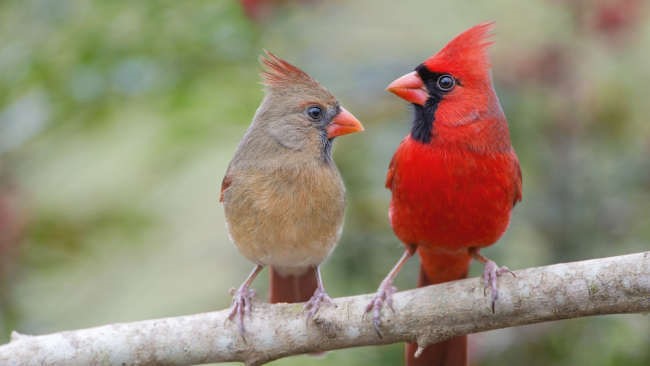
Pairs of northern cardinals usually mate for life. Once a pair is established, they will usually continue mating with the same bird until one of them dies. However, there are occasions wherein the pair fails to successfully reproduce, thus ending their partnership with a “divorce.” The birds end up seeking other mates.
Despite their extremely cute appearance, these birds are fierce. Males care for their mates dutifully while the females incubate their eggs. Both of the parents viciously defend their territory and nest against intruders, whether real or assumed. Some have even been observed to attack their own reflection as an attempt to drive the other bird away.
Mating and Breeding
Northern Cardinals are monogamous birds, which means that they mate for life. If the couple can produce healthy offspring, they may stay together for quite some time, though they may divorce if needed in order to find a better and more suitable mate. A mated pair of Northern Cardinals are usually seeded eating together, with the male gently offering seed to his partner in a “beak-to-beak” method, making them look like kissing.
Pairs stay together throughout the year, joining with other cardinals in order to form large flocks during winter. This results in a stunning view when a large group is spotted, especially in a snowy landscape. A flock of these cardinals may be called a conclave, college, Vatican, or radiance.
As these birds are serially monogamous, pairs usually stay together for only one breeding season. During this season, both male and female cardinals engage in displays of courtship, swaying from one side to another with their crests erect, necks outstretched, singing softly. They may also offer other birds with a seed, touching their beaks briefly as they usually do so.
The breeding period usually happens from March to September, with usually two broods every year. One starts around March, while the other usually happens from late May to July. The eggs are usually greenish or bluish in color, spotted with brown hues. During the incubation period, the young ones are fed only by the female through the males.
The female cardinal usually broods her altricial chicks during the first two days, with both parents feeding them. The chicks begin to fledge as they reach about 7 to 13 days old, and are continuously fed around a month right after leaving the nest. Afterward, they will join a flock of juveniles. When they reach one year old, they become sexually mature.
Once a clutch of eggs has been laid inside the nest, only the females mainly do the incubation. Within this time, the male uses all of this energy in defending the nesting area against intruders, while bringing food to his mate. After the eggs hatch, both parents take the responsibility of feeding their young ones. When a series of clutches are laid, the male takes on the responsibility of raising the fledglings if they are still around, so that the females can again concentrate on incubating her eggs.
Funny Attacks
Many people seemed perplexed, especially every spring, with sights of cardinals attacking their own reflection in car mirrors, windows, or even shiny bumpers. This is a behavior observed with both males and females. Usually, this happens in spring or in early summer, when they are most obsessed with defending their territory against imaginary intruders. Birds may even be observed fighting these ‘intruders’ continually, with no intention of giving up. A few years later, however, as their levels of aggressive hormones start to subside, these attacks also end, supposedly. There was a record, though, of a female cardinal keeping up with this behavior each day, continuously for six months.
Value to the Environment
Since Northern Cardinals eat a lot of fruits and seeds, they serve as seed dispersers for many plants. They may also actually have an impact on the composition of the plant community with their seed-eating. At times, brown-headed cowbird chicks are raised from eggs that have been laid in the nests, thus helping the populations of these birds even further.
Human Interaction
These birds are strongly attracted to bird feeders. As such, they are a common sight in urban areas for this reason. The best way to attract northern cardinals is by setting up safflower and sunflower seeds in the bird feeder.
Before the Migratory Bird Treaty Act in 1918 was introduced, northern cardinals were popular pets because of their song and color. They have been threatened because of habitat destruction, though the preparation of bird-friendly foliage in gardens and parks, including the setup of bird feeders, also helps in keeping their population stable.
Molting
Northern cardinals molt at least once a year. This allows them to replenish damaged features. In this process, the birds lose some, even all of their feathers for about two weeks. From time to time, the birds look like they have gone completely bald, showing the dark grey or black skin on their heads when they become featherless.
Diet
Northern Cardinals are described as granivorous birds. This means that they make good use of their huge, powerful bills in order to crack a wide range of different seeds. They also eat other food items such as berries, fruits, insects, and grains. This capacity allows them to forage for a variety of food during seasonal changes while helping them stay in their range all year round.
It has been observed that 90% of the food intake of Northern Cardinals is sourced from berries, grains, fruits, and seeds. Their foraging activity usually includes hopping along the ground under bushes in order to search for dropped berries and seeds. When provided with the opportunity, these birds feed on a wide variety of insects, though insects do not make up a huge portion of their diet. Young ones, however, are fed exclusively with insects.
Interesting Facts
Here are some interesting facts about Northern Cardinals:
- The name ‘Northern Cardinals’ can be dated back to the time of the founding colonists of the United States. The origin of the name stems from the similarity of the vibrant red plumage of the males to the red biretta and vests of Catholic cardinals.
- Cardinals are “early birds.” They are the first ones to visit feeders early in the mornings and the last to drop by in the evenings. Even though ornithologists are not sure of the reason behind this, it has been believed that it may be associated with lower competition with other bids during dawn and dusk. Male cardinals also seem to be more inconspicuous in low light conditions, thus providing them a measure of security for predators.
- During the courtship period, affection between the birds is expressed with the males feeding their mates seeds through “beak to beak.” It looks so romantic that when they do so, it seems like the birds are kissing.
- Northern Cardinals are characterized as granivorous. This is because they usually thrive on a diet that consists mostly of seeds. Their stout, short and cone-shaped beaks are designed especially for cracking open the hulls on seeds, and shells on nuts. Because they love seeds so much, they can easily be attracted to feeders using either safflower or sunflower seeds, shelled peanuts, or cracked corn.
- In the wild, the average lifespan of Northern Cardinals is about three years due to the different hazards that they are exposed to. This includes disease, predators, starvation, and accidents.
- On occasions, a lack of the usual red pigment in the plumage happens and is often replaced with orangish or vibrant yellow pigments, which results in having a yellow cardinal. This appearance is usually caused by a genetic plumage variation that is referred to as xanthochroism.
- In winter, Northern Cardinals typically forego their territorial behavior and gather together to create flocks. A group that searches for food is more effective than a lone cardinal, or pair. These flocks are often called a conclave, college, radiance, deck, or Vatican or cardinals.
- The Northern Cardinal is a mascot that is popularly used by several sports teams. This includes two professional teams, including the Arizona Cardinals NFL team and the St. Louis Cardinals. They also represent colleges, including the Concordia University, Ball State University, the University of Louisville, and the Wesleyan University.
- Male Northern Cardinals usually go through an increase in hormone levels during the mating and nesting season. At this point, they become really territorial, even attacking any intruders that they consider a threat to the group.
- The song of Northern Cardinals sounds like they are saying “cheer, cheer, cheer,” or “birdie, birdie, birdie.” Their unique pattern of vocalization allows birders to identify the cardinal easily when they are singing.
Beliefs and Superstitions
Religion seems to play a role in the naming of this bird. European settlers observed the bright red plumage of these birds and were easily reminded of the red vestments which are usually worn by Catholic cardinals. For them, the crest of this species also reminds of the pointed headgear that is usually worn by higher officials of the Catholic religion.
Conservation and Threats
Back in the 1800s, Northern Cardinals became popular as cage birds because of their sweet songs and brilliant plumage, making them very attractive. Bird poaching is something that became a threat to the population of cardinals. Fortunately, though, they are now being protected under the Migratory Bird Treaty Act, along with other legislations.
During the past 200 years, northern cardinals have increased, both in number and in geographic range. However, habitat loss towards the edge of their range, especially in southeastern California, may result in the loss of the population of this species in the area.
Backyard Tips
Almost all bird feeders set up need to attract Northern Cardinals, given that you live within their range. These birds, however, seem particularly interested in sunflower seeds, which means that they can be used effectively in bird feeders. As suggested by some backyard owners, it is observed to be effective, leaving undergrowth in your backyard, or surrounding the edges.
Care in Captivity
One important thing to know about northern cardinals is that this species has not been domesticated in any possible way. In fact, it is considered extremely illegal to kill, own, or harm this species for any reason. These birds, as well as the vast majority of bird species, are currently under the protection of the Migratory Bird Treaty Act.
If you are interested in keeping a Northern Cardinal as a pet, just like with other native birds, it is best to become licensed in your home state as a wildlife rehabilitator. This will allow you to take care of injured birds. In certain cases, you can even have under your care those that become un-releasable in the wild.
It is very important to provide a home for them that mimics their natural habitat. They usually favor park-like and suburban habitats, which means that they respond quite well to the presence of humans. As a matter of fact, this particular species is observed to be increasing both in population size and range in several areas. In contrast with other birds, females sing loudly from their nest, with a song that is described as more complex than those of males.
Based on the experience of individuals who have cared for these birds at home and in zoos, northern cardinals are suited best in outdoor enclosures. Aside from being active birds, those that are kept indoors decline in both condition and color. The carotenoids that give these birds their red color are only acquired from their diet, which suggests that insects that they capture outdoor assist in this regard.
In a zoo setting, these birds are easy to care for. They only need to be provided with a lot of flight space, though they do not really need extensive enclosures because they are relatively small in size. Their diet is also quite easy to replicate, mainly because there are currently available songbird foods that are commercially common. These birds also need to be provided with various perches and branches, along with novel feeding stations.
FAQs
In which biome do Northern Cardinals live in?
For Northern Cardinals, temperate deciduous forests are appropriate places to thrive and survive. These forests are usually found in the Eastern part of the United States and Canada, in most parts of Europe, as well as certain parts of Japan and China. This biome is one that always changes, with four distinct seasons, winter, spring, summer, and fall.
What is special about Northern Cardinals?
In terms of appearance, female cardinals feature a soft and warm tan color, with red edging to their wings and tail, and a bright orange bill. Both males and females are adept at singing, even singing all year round. Female cardinals usually sing while sitting on the nest, which may send a message to their mates about the need for more food.
Where do Northern Cardinals go during winter?
In wintertime, Northern Cardinals typically seek refuge in evergreen trees, looking especially bright in this season with fresh snow in their background. Pairs of cardinals usually stay close together all throughout the year. Seeing a lone cardinal means that its mate is nearby.
Do Northern Cardinals migrate?
These birds are also called “redbirds.” They do not migrate. They have been found to be present in warmer locations, including the Southeastern part of the United States. In recent decades, however, these birds have further expanded their usual range north of the United States and even into Canada.
How do Northern Cardinals adapt to their environment?
Since these birds are mainly seed eaters, they are designed with specially adapted beaks that help them with their diet. They still eat insects and fruits. Their thick, short, and conical beaks allow them to crack seeds easily, get through the husk, and eat the delicious meat inside.
Where do Northern Cardinals live?
Northern Cardinals are found throughout the eastern part of the United States, and south into Mexico and other parts of Central America.
What is the myth behind seeing a red cardinal?
According to myths, a cardinal represents a loved one who has passed. This means that if you see one, they are visiting you. Red is also a color of passion, love, and devotion. Thus, a red bird symbolizes the fire of life that burns inside our souls, even in the coldest and darkest times.
What sound do Northern Cardinals make?
The song that Northern Cardinals make is a loud series of clear, two-parted, and down-slurred whistles. The sound often speeds up and ends in a slow trill. The songs usually last for about 2 to 3 seconds. The syllables may sound like “birdie, birdie, birdie,” or “cheer, cheer, cheer.”
What attracts Northern Cardinals to the backyards?
These birds are usually attracted to food found in some backyards. They have a thick and helps bill that is perfect for large seeds. As such, sunflower seeds are their favorites. Other foods that they prefer include peanut pieces, cracked corn, apple chunks, and fresh berries.
Do Northern Cardinals eat worms?
Northern Cardinals eat seeds, insects, and fruits. They may be birds, but the expression “the early bird catches the worm” does not apply to them, even if they are among the first birds up every morning.
How do Northern Cardinals survive the winter?
Northern Cardinals have stored fat during the short days of winter. This will help keep themselves warm throughout the long nights. They simply fluff their feathers in order to trap heat, thus slowing metabolism and conserve energy.
How many types of cardinals are there?
There are three recognized cardinals that belong under the genus Cardinalis, even though birds of the same family with a different genus are still referred to as cardinals.
How do Northern Cardinals protect themselves?
Northern Cardinals have the tendency to live at the edges of woodlands, as well as in the vegetation near gardens and houses. Male cardinals defend their territory quite aggressively. As a matter of fact, male cardinals may even defend their territory from their own reflection in a mirror or window.
How do eggs of Northern Cardinals look like?
Eggs of these birds are glossy white, or pale green, and smooth in texture. They have brown, gray, or reddish speckles throughout their body, which becomes denser towards the larger edge. Open woodlands with bushes and scattered trees are generally the preferred nesting site of these birds.
Do Northern Cardinals use birdhouses?
Unlike several other backyard birds, Northern Cardinals do not use nesting boxes or birdhouses.
How long does it usually take for a male Northern Cardinal to turn red?
When the Northern Cardinal males reach around 12 months old, they usually start to molt and thus make the transition to their next color phase.
Is it true that a Northern Cardinal is a character used in the Angry Birds game?
Yes. The red angry bird is actually a Northern Cardinal. Being an angry bird is also a good representation, as Northern Cardinals are capable of nasty bites.
How many days is the usual incubation period of Northern Cardinals?
The incubation period of eggs usually takes 11 to 13 days, with 7 to 13 days of the nesting period.
Are Northern Cardinals protected birds?
These birds were once prized as pets because of their bright color and unique song. Under the Migratory Bird Treaty Act of 1918, however, this species receives special legal protection in the United States. They are also banned as cage sale. They are also protected under the Convention for the Protection of Migratory Birds in Canada.
How long do Northern Cardinals live?
On the average, Northern Cardinals live for a period of 3 years in the wild, even though several have reached life spans of 13 to 15 years. The longest record of a captive Northern Cardinal is 28 and a half years.

